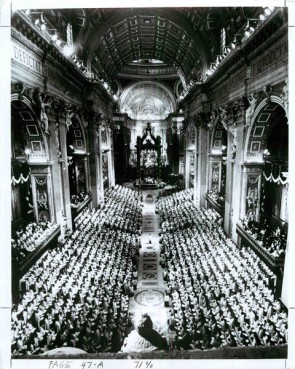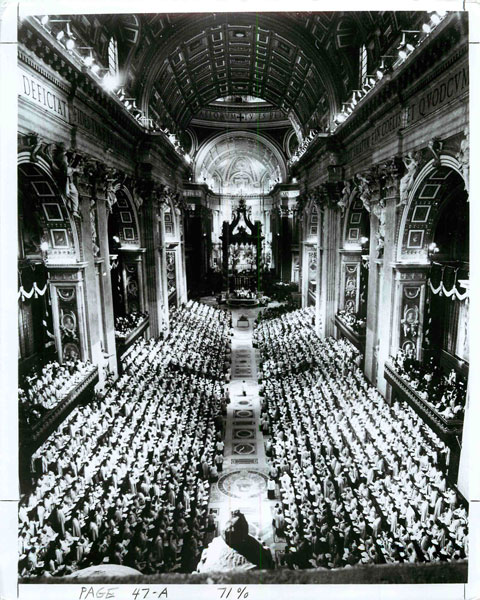(RNS) On Oct. 28, 1958, Cardinal Angelo Giuseppe Roncalli, a rotund jolly Italian was elected to succeed the recently deceased Pope Pius XII.

Vatican City — Prelates and religious dignitaries from around the world fill St. Peter’s Basilica as a concelebrated Mass opens the Second Vatican Council on Oct. 11, 1962.
At age 77, most of the world believed that the new Pope John XXIII would be a caretaker pope, an interim leader who would maintain the status quo and permit the entrenched bureaucracy to preserve things as they were during the long reign of his predecessor. Elected on the 12th ballot, some even called Roncalli an “accidental pope.”
How wrong they were.
Just three months after his election, John XXIII called for the world’s Catholic bishops to gather for a second Vatican Council to chart the church’s future in the post-World War II era.
Because people underestimated John XXIII, his plans initially received little attention, but things changed when he used a vivid image to describe his plans: the council would serve, he said, to “throw open the windows of the church and let the fresh air of the Spirit blow through.”
Clearly, he was serious about confronting the scientific and intellectual revolutions of the 20th century, the legacy of two world wars, communism, fascism, and Nazism, and especially the horrific Holocaust. John XXIII wanted Catholics to face up to that dismal history — and Christians’ role in it — and make positive changes vis-a-vis Jews and Judaism.
Exactly 50 years ago this month, more than 2,000 bishops arrived in Rome and began complex deliberations that eclipsed John XXIII’s own death in 1963 and concluded in 1965. During that time, many ecclesiastical reforms were debated, none more important than the Catholic Church’s frequently negative and turbulent relations with Jews and Judaism.
Indeed, Catholic-Jewish relations became a central topic of what became known as Vatican II. In the midst of the Holocaust, Roncalli had written: “We are dealing with one of the great mysteries in the history of humanity. Poor children of Israel. Daily I hear their groans around me. They are relatives and fellow countrymen of Jesus.”
Before and during the war, Roncalli was the Vatican’s top diplomat in Turkey and Greece; in 1944, he was transferred to Paris as the Vatican ambassador to France. The future John XXIII used his Vatican credentials to save thousands of Jews in Europe.
The pope wanted his church to officially change its teaching, preaching, liturgy and beliefs about Jews and Judaism. He and other Catholic leaders, including many American Catholics, desired a new relationship with “the relatives” of Jesus — one built upon mutual respect and understanding, not bigotry and hatred.
It all sounded good when things got started in October 1962, but it was no small thing for a global church to eradicate the long-standing pathologies of anti-Judaism and anti-Semitism that were embedded in the hearts and minds of many Catholics throughout history. Although deicide was never an official doctrine of Catholicism, the obscene and lethal charge of “Christ killers” had been hurled against Jews for nearly 2,000 years.
It was an enormous task to transform the church’s encounter with the Jewish people and Judaism. But John XXIII’s leadership — followed by that of his successor, Paul VI — inspired a host of Catholic clergy and laity to work together to achieve purposeful change throughout the church.
After many drafts and sometimes bitter debates, the now historic declaration Nostra Aetate, (Latin for “In Our Time”) was adopted by the bishops in October 1965 by a vote of 2,221 to 88. The declaration, less than 1,600 words in length, specifically denounced anti-Semitism, urged “mutual respect and understanding” and the establishment of “biblical and theological studies” as well as “fraternal dialogues” between Catholics and Jews.
While the term “deicide” does not appear in the final text, Nostra Aetate effectively served as a formal rejection of the charge of Jewish culpability for Jesus’ death.
In the 50 years since Vatican II, much has been accomplished in building a new relationship between Catholics and Jews, even as more work is required. However, what John XXIII began in October 1962 represented the beginning of the end of anti-Judaism and anti-Semitism within the Catholic Church.
(Rabbi Rudin, the American Jewish Committee’s senior interreligious adviser, is the author of the recently published “Cushing, Spellman, O’Connor: The Surprising Story of How Three American Cardinals Transformed Catholic-Jewish Relations.”)
KRE/AMB END RUDIN





